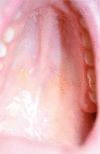Factors causing oral and skin pathological features in the hyperimmunoglobulin E syndrome patient including the environmental component: a review of the literature and own experience
- PMID: 32792871
- PMCID: PMC7394163
- DOI: 10.5114/ada.2020.96142
Factors causing oral and skin pathological features in the hyperimmunoglobulin E syndrome patient including the environmental component: a review of the literature and own experience
Abstract
The hyperimmunoglobulin E syndrome (HIES) is a rare multi-system disease with non-immunological as well as immunological abnormalities. The syndrome is characterized by a triad of the most distinctive symptoms, such as pneumonia with pneumatocele formation, recurring staphylococcal skin abscesses and a high serum concentration of IgE. Central mediators of immune responses such as STAT1 and STAT3 affect immune responses and contribute to changes of the skin microbiome which subsequently can amplify the defective immune response against microbial and fungal pathogens. Reactions related to an environmental factor, such as sun-induced skin changes, in individuals during long-term medication therapy have also been reported. The dermatological symptoms, oral status and other health problems of a hyperimmunoglobulin E syndrome paediatric patient are presented. HIES is of great importance to different professionals because sufferers require special preventive and therapeutic management from early infancy in order to avoid complications which can even prove to be life-saving for such patients.
Keywords: HIES); dermatological manifestation; environmental factor; hyperimmunoglobulin E syndrome (hyper-IgE syndrome; oral finding.
Copyright: © 2020 Termedia Sp. z o. o.
Conflict of interest statement
The authors declare no conflict of interest.
Figures




References
-
- Kamasaki Y, Hidaka K, Nishiguchi M, Fujiwara T. Dental manifestation of a pediatric patient with hyperimmunoglobulin E syndrome: a case report. J Dent Child. 2012;79:100–4. - PubMed
-
- Verma S, Wollina U. Job’s syndrome – a case report. J Eur Acad Dermatol Venereol. 2003;17:711–4. - PubMed
-
- Grimbacher B, Holland SM, Gallin JI, et al. Hyper-IgE syndrome with recurrent infections – an autosomal dominant multisystem disorder. N Engl J Med. 1999;340:692–702. - PubMed
-
- Abhilash N, Radhakrishnan S, Arun MV, Sasidharan PK. Congenital immunodeficiency disorder. J Assoc Physicians India. 2007;55:808–9. - PubMed
-
- Davis SD, Schaller J, Wedgwood RJ. Job’s syndrome. Recurrent, “cold” staphylococcal abscesses. Lancet. 1966;1:1013–5. - PubMed
Publication types
LinkOut - more resources
Full Text Sources
Research Materials
Miscellaneous
